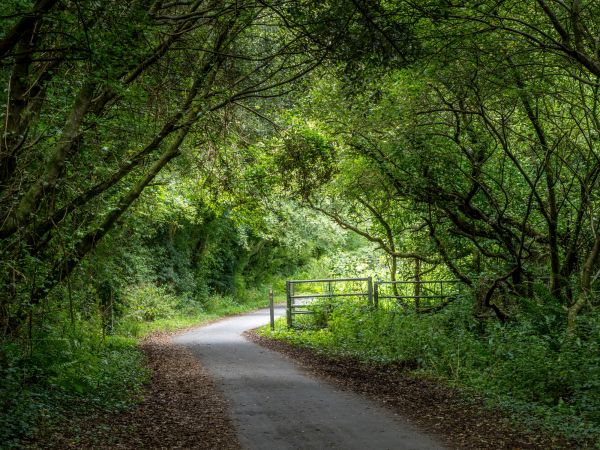Challenges experiencing nature in a wheelchair

We're a family of four: mum Charlotte, dad James, Harry aged five and Josie aged seven. Josie has a rare form of muscular dystrophy. We live in the South Downs, a stone's throw from Lewes and we're an extremely outdoorsy family.
Josie was diagnosed at the age of four and a half with a rare muscle wasting condition called Ullrich congenital muscular dystrophy (UCMD). We had started the diagnosis process when she was about 18 months old when we realised that she wasn't meeting all her development milestones. Josie can walk but it is progressively getting more difficult for her. She can’t climb stairs. She can't jump or run. For anything outside she uses a power wheelchair because she just can't cope with any distance or with uneven ground due to lack of muscle stability. But she is a bright and lively seven-year-old who wants to be part of absolutely everything. Every day is a learning experience with Josie’s condition because it is progressive. We have made adaptions to the house and created a downstairs room for her that's totally accessible, and that we hope is fairly future proofed for her.
Where we live, we’re surrounded by fields. The very reason we moved here was to enjoy being outdoors and to bring our children up enjoying the outside world. So about two years ago, we bought Josie an off-road wheelchair so that we can explore the South Downs National Park. We wanted to give Josie access to nature and some freedom. But we hadn’t realized just how many challenges there are everywhere for wheelchair accessibility. There are just so many barriers. And if you haven't experienced using a wheelchair firsthand, you just don’t understand the issue.

We live not far from the River Ouse. From our house you can walk down a country lane and it takes about 20 minutes to walk into Lewes along the riverbank. About a year ago the Environment Agency were working on the riverbank to do with the flood defences. And as part of the work they were doing they added a path along about half of the riverbank. They also replaced some of the old-fashioned kissing gates with swing gates which makes it so much more accessible. Each time we walked past I said to the workers, “I hope you aren’t putting those kissing gates back in”. I spoke to the National Park, I spoke to the park rangers, I spoke to the landowner, to the Environment Agency. The Rangers wanted there to be swing gates, but the farmer was very reluctant to have those. In the end they've put in accessible kissing gates. But I'd say they are accessible to some people, but certainly not everyone.
Fortunately for us, Josie can manoeuvre her wheelchair through them as she's very skilled at using it. But a mobility scooter wouldn’t get through them. And if Josie was on her own, she wouldn’t be able to use them as she wouldn’t be able to reach the latch. It’s frustrating because yes, they have gone some way to making the route accessible, but not as far as they need to go. And it’s probably the only place in the South Downs National Park that I can think of where things are moving in the right direction. Everywhere else there are lots of stiles.
Josie knows and accepts that she has limitations. She likes being in her wheelchair and the freedom that that gives her. But as she gets older, the more she is going to get frustrated. National Parks like the South Downs should be accessible for everybody to be able to explore. The National Park Authority should be making more of an effort to make it accessible for everybody. Whether its funding or whatever might be needed to make areas of natural beauty accessible spaces, people should be doing the best they can with the land around them to make it accessible to everybody. It’s the environment that disables people and we need to think about installing gates that have latches that disabled people can reach. Simple things like this improve the accessibility of an area. We need to look at what can easily be adapted or updated so that we’re allowing more people to get access.

As a disabled person you have enough barriers as it is, without having to deal with preventable barriers. If an able-bodied person wants to go for a walk, they just have to put on their shoes and go. They don't have to think about whether there's going to be a kissing gate, or a narrow path, or what kind of landscape they’re going to come up against. There’s an ignorance and lack of understanding of the impact on disabled people. Disabled people are a minority and they have to fight for equality which is insane. Just because they're a minority doesn't mean that they shouldn't have the same ability and right to access open space, just like everybody else.

10 great routes for wheelchair users
Absorb history, wildlife and a sense of freedom whilst exploring these well-surfaced wheelchair-friendly trails.

Accessibility: Walking for everyone
Awareness is growing about how to make Great Britain’s most beautiful places accessible. We know getting out into green and blue spaces can give your health and wellbeing a much-needed boost.

6 things we can all do to make walking in nature more inclusive
Heading out into nature can be more challenging for some. So here are six ways we can support those with the least access and most barriers to the outdoors.